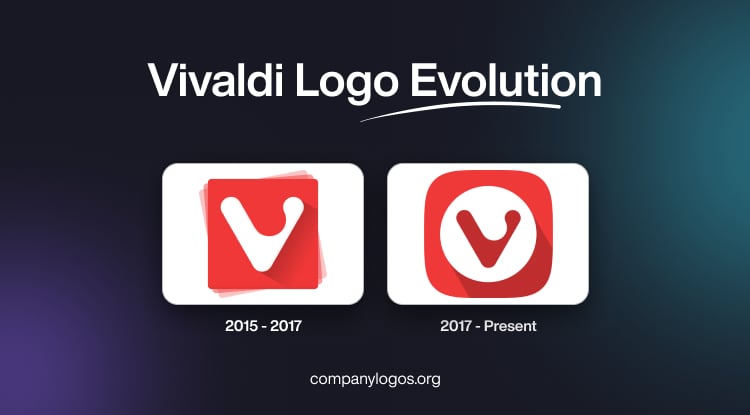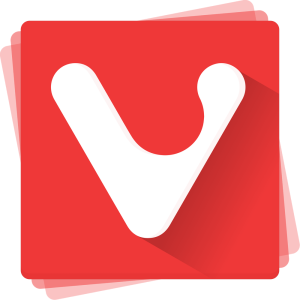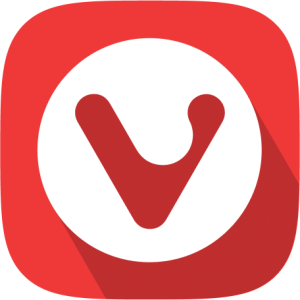
Vivaldi is a highly customisable, privacy-focused web browser launched in 2015 by Jon von Tetzchner, who was the co-founder and former CEO of Opera. It was created as a response to the simplification of mainstream browsers. In fact, Vivaldi aimed to restore and expand advanced features for power users while remaining accessible to everyone. Built on the Chromium engine, the browser ensures compatibility with modern web standards.
The Vivaldi logo has evolved alongside the browser and reflects changes in design philosophy, company identity, and user expectations over time. While the core “V” has remained, its style has shifted to reflect the maturity of the company and the unique character of the browser.
The Genesis of the Vivaldi Logo (2015 – 2017)
The original Vivaldi logo was created by external designer Sean O’Grady. It featured a rounded skeuomorphic “V”, which was an approachable and memorable image that helped establish brand identity during the early phase of Vivaldi, following the legacy of Opera. The “V” mark was placed inside the red background with glossy shadows and gradients. In fact, the “V” mark symbolised flexibility and friendliness and was chosen to be recognisable and to reflect the user-focused, customisable nature of the browser.

(2017 – Present)
The current logo was designed in 2017, and it retained the signature rounded and skeuomorphic “V”, but in a more minimalist and flat style. The logo was simplified and modernised in its appearance to reflect the playfulness of the browser. It did away with the heavy gradients and shadows of the original logo, as they made the logo tricky to be used across platforms. The current “V” mark in red has a rounder silhouette and a cleaner geometry. It is placed inside a white circle, the two of which are further enclosed within a red square with rounded corners.

The Elements of the Vivaldi Logo
Symbol
The Vivaldi logo does not have a traditional wordmark but a graphical emblem with a bold and playful design. The central element of the logo is the stylised white “V”, drawn in a smooth, rounded form. The letter almost resembles a hand-painted or brush-like stroke. This gives the letter “V” a friendly, approachable, and human feel and conveys Vivaldi’s philosophy of being a browser made for people, not corporations. The “V” is not based on any standard font but is instead a custom logomark.
Colour
The Vivaldi logo has a colour palette comprising vibrant red and white. The colour red conveys energy, passion, and creativity. The white-coloured “V”, on the other hand, signifies clarity, openness, minimalism, and trust. Also, the stark white colour of the letter “V” stands out to symbolise freedom of choice.
The History of Vivaldi
Vivaldi is a Norwegian freeware, cross-platform web browser developed by Vivaldi Technologies and launched on January 27, 2015. It was created by Jon Stephenson von Tetzchner and Tatsuki Tomita, with von Tetzchner being a co-founder and former CEO of Opera Software. The browser emerged primarily as a response to discontent with Opera’s shift from its Presto engine to a Chromium-based engine. This shift led to the loss of many features that Opera users cherished. Vivaldi aimed to revive and expand on those unique functionalities while leveraging Chromium’s foundation for performance and compatibility.
Vivaldi began as a virtual community website designed to compensate for the closure of the My Opera community by Opera Software in 2014. Von Tetzchner valued the My Opera user community and launched the Vivaldi Community to continue that sense of connection and discussion among users. Eventually, this community evolved into the browser project itself.
The first technical preview of the Vivaldi browser was released in January 2015. It quickly attracted enthusiastic downloads, that is, about 500,000 within the first ten days. The browser got its name from the Italian composer Antonio Vivaldi and was chosen for its global recognisability and simplicity.
The first stable version of the browser was launched on April 6, 2016, with support for Linux, macOS, and Windows. Vivaldi differentiated itself with extensive customisation. In other words, it allowed users to have granular control over the user interface. Further, it had advanced built-in tools designed to appeal particularly to power users and former Opera fans who missed the legacy features.
A key development was the creation of an innovative “History” feature introduced in Vivaldi 1.8, released around 2017. Unlike the simplistic history tools in many browsers, Vivaldi’s History offered users deep insights into browsing patterns. These include customisable views by day, week, or month, and visual analytics like heat maps and statistics. This reinforced Vivaldi’s philosophy of providing tools that help users understand and control their browsing experience thoroughly.
In 2021, Vivaldi replaced Firefox as the default browser in the Manjaro Cinnamon Community Edition of the Manjaro Linux distribution. And despite not being open-source, Vivaldi has garnered praise for its feature-rich and highly configurable nature. Vivaldi continues to develop features that are targeted at users who want a powerful and customisable browsing experience that respects privacy and enhances productivity.
Interesting Facts About Vivaldi
- Vivaldi was created in 2015 by Jon von Tetzchner, the co-founder and former CEO of Opera. He did so after Opera shifted away from its power-user focus.
- It began as a community platform for ex-Opera fans, then evolved into a full-fledged browser.
- Vivaldi is available on Windows, macOS, Linux, Android, iOS, and even in cars via Android Automotive.
- Vivaldi is famous for letting users adjust almost everything: tab position, toolbar layout, themes, keyboard shortcuts, and even mouse gestures.
- Vivaldi allows users to set their browsers to automatically change themes depending on the time of day.
- On iOS, Vivaldi lets users choose alternative app icons for personalisation.
- Unlike most browsers, Vivaldi allows users to group tabs into stacks and even display them in two rows.
- Vivaldi supports tiling tabs side-by-side within one window.
- The Vivaldi browser has its own Notes app, Mail client, Calendar, Feed Reader, Translate, and even a screen capture tool.
- It provides a sidebar where users can pin websites (like chat apps, news feeds, or tools) for quick access.
- Vivaldi blocks trackers and ads (with configurable settings) and doesn’t track user behaviour.
- The company is independently owned and insists that user data is never for sale.
- Vivaldi allows bookmarks, notes, and settings to sync across devices with encryption.
- Vivaldi became the first full web browser available in cars when it launched on Polestar EVs in 2021.
- Vivaldi has expanded to more automotive platforms, such as certain Renault and Volvo models.
- Vivaldi maintains close contact with users and often shapes features that are based on community feedback.
- With the Vivaldi browser, hidden quirky touches appear from time to time, such as playful start-up animations or seasonal surprises.
Finally
The Vivaldi logo and its iteration reflect the browser’s philosophy, “adaptability without losing identity”. The original logo with a glossy, skeuomorphic “V” badge changed to a cleaner and flatter design in 2017. The logo has been refined to suit modern design standards while staying instantly recognisable. Also, by maintaining the essence of the original logo while adapting its design, Vivaldi has crafted a distinctive brand. The Vivaldi logo resonates with its mission of empowering users and embracing creativity in the browser space.